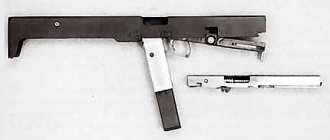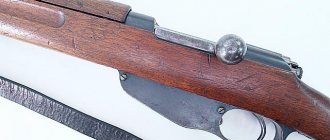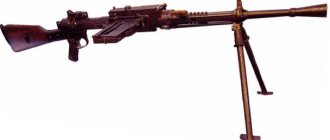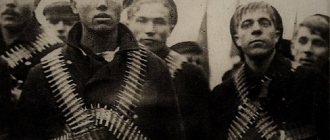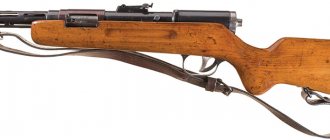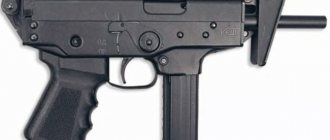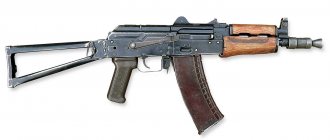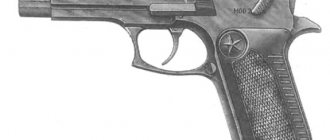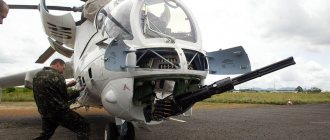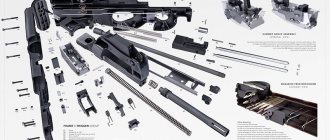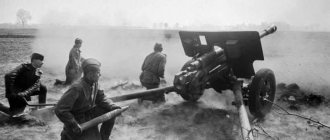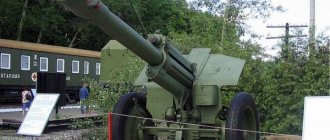Degtyarev submachine guns PPD-34 and PPD-40
In the 30s XX century In many countries around the world, great attention was paid to the development and improvement of submachine guns. This was due to the fact that this type of weapon had an extremely simple design and had a high rate of fire. At the same time, as practice has shown, the effective firing range of submachine guns was extremely short, so they were not able to completely replace the rifle. Thus, there could be no question of accepting them as the main model of infantry weapons. Almost everywhere, both rifles and submachine guns were in service - two very different types of weapons that fired different cartridges. A similar situation with a new type of weapon developed in the Soviet Union.
The development of this type of small arms, such as a submachine gun, began in the Soviet Union only in 1925. The impetus was the military reform to rearm the Red Army, carried out by the Soviet government after summarizing the experience of the First World War and the Civil War. It is believed that the first example of a Soviet submachine gun (in those years called a “pistol-carbine”) was created by F.V. Tokarev already in 1927. Following him, in 1929, V.A. presented his sample of a submachine gun for testing. Degtyarev. The weapon had much in common with the design of the light machine gun he created in 1927 - a semi-free bolt with lugs extending to the sides, a similar design of the receiver and disk magazine with a capacity of 22 rounds. During the tests, both models showed good firing characteristics and withstood competition with the MP 18 submachine gun of the German designer H. Schmeisser. However, they had a main drawback - they were designed to use a low-performance revolver cartridge of the Nagant system (7.62x39 mm), while the Soviet Union had already adopted a Mauser converted to a three-line caliber (original caliber 7.63x 24 mm) pistol cartridge 7.62×25 TT (TT - from the name of the Tokarev system pistol in which it was used).
The new cartridge was developed in 1929 on the instructions of the Artillery Committee based on the requirements for modern small arms. It fully ensured reliable defeat of the enemy in close combat, had sufficient bullet penetration at a distance of up to 500 m and at the same time was lighter, had smaller dimensions and low recoil energy. The appearance of such a cartridge opened up wide opportunities for Soviet gunsmiths to create new unified models of small arms that, in comparison with classic rifles, are lighter, more compact, faster-firing, with a large magazine capacity, and at the same time simpler, more economical and quite reliable.
Read: Torpedoes 53-65 are still formidable
Degtyarev became the first inventor who modernized his submachine gun to use a new cartridge, which made it easier to supply troops with ammunition, and in production the barrels for the TT and the submachine gun were made on the same equipment.
As a result, its improved model was put into service in July 1935 under the designation PPD-34 (Degtyarev system submachine gun model 1934). Unlike the model arr. 1929 PPD-34 had automation, the operation of which was carried out by using the recoil energy of the free shutter. Due to the lack of experience in using submachine guns in combat conditions, as well as due to a number of their inherent disadvantages, expressed in the limited range of effective fire and, according to popular opinion, too much ammunition consumption, the PPD-34 did not receive proper evaluation in the army .
Tactical and technical characteristics of the PPD-34 submachine gun
The armament of infantry with this type of weapon proceeded very slowly. Just as in many European countries submachine guns were viewed with distrust, the Soviet military command could not reach a consensus regarding the mass use of this type of weapon. Some representatives of the Soviet government and generals not only expressed dissatisfaction with the insufficient firing range, but also generally questioned the advisability of using submachine guns and objected to their widespread use. This led to the fact that the production of PPD-34 was not given enough attention and even various types of restrictions were introduced.
Ultimately, the erroneous classification of submachine guns as purely “police weapons” led to the fact that, starting in February 1939, the production of PPD-34 was discontinued. Soon they were not only removed from service with the rifle units of the Red Army, but were even removed from the troops and transferred to warehouses. The main argument in favor of this action was that the repeating rifles of the Mosin system had better fighting qualities. According to approximate data, in total during the period from 1934 to 1939, no more than 5,000 PPD submachine guns mod. 1934
However, already at the beginning of the Soviet-Finnish war, the attitude towards submachine guns changed dramatically. Finnish infantrymen, armed with Suomi submachine guns, created such effective fire that the leadership of the Red Army was forced to urgently organize the delivery of PPD-34 to the front line and resume their production. In the shortest possible time, all PPD-34 stored in warehouses and confiscated from border guards were delivered to the front by plane. The production of submachine guns was transferred to a three-shift operating mode using all equipment. In addition, according to some data, rifle units manufactured in the 1920s entered service with the rifle units involved in the conflict. automatic rifles (machine guns) of the Fedorov system mod. 1916
Read: Flamethrowers "FOG"
Moreover, by personal order of I. Stalin, who was usually the first to blame automatic weapons for excessive consumption of ammunition, the submachine gun was modernized with the main goal of increasing the magazine capacity.
In parallel with the release of the submachine gun mod. In 1934, a decision was made to modernize it due to the fact that the Finnish Suomi submachine guns were equipped with larger magazines designed for 71 rounds. In just a few days, a group of Soviet designers, which included I. Komaritsky, D. Shchelkov and E. Charnko, developed a capacious disk magazine with a capacity of 71 rounds, and V. Degtyarev modernized his submachine gun for it. Unlike its predecessor, it had a split stock to accommodate a disc magazine that had no neck. In addition, an improved sight was installed on the new submachine gun and a more compact barrel casing was created with four rows of slightly smaller slots. The modernization of automation affected primarily the firing pin mechanism. In the new model, it was driven by a lever, which, immediately before locking the barrel, hit the body of the submachine gun and transmitted the shock impulse to the firing pin.
In January 1940, an improved submachine gun was presented to the commission and a month later it was put into service in infantry units under the name PPD-40 (Degtyarev system submachine gun model 1940).
Tactical and technical characteristics of the PPD-40 submachine gun
Its production was urgently launched at the Tula arms factories, but, according to some sources, the bulk of the PPD-40 that entered service with the units that participated in the combat operations of the Soviet-Finnish War was manufactured at the Voskov plant, located near Leningrad.
Another modification of the Degtyarev PPD-34/38 submachine gun with a solid stock is also known, for which both standard horn magazines from the PPD-34 and new 71-cartridge drums with a neck were used. However, this “transitional” model was not the most widespread. During the Soviet-Finnish War, submachine guns of the Degtyarev system were well tested during combat operations in low temperatures, in snow, forests and swamps, and performed well during combat operations in rocky terrain, where large-scale use of infantry and tanks was impossible .
Read: Armored cruiser "Admiral Nakhimov"
Shooters were especially pleased with the large ammunition capacity, although the weight of the PPD-40 with a full magazine exceeded 5 kg. In battle, this made it possible to create a high density of fire, and the large weight of the weapon when firing reduced the influence of the recoil force on the movement of the barrel from the aiming line. In addition, it was noted that the submachine gun has a comfortable stock, and this ensured good grip and ease of aiming. The PPD-40 was small in size, which made the weapon more convenient compared not only to a rifle, but also to a carbine, when firing from vehicles, for combat operations in conditions of limited space (in trenches, corridors and rooms of buildings, etc.). P.).
At the same time, over the years of production and operation of the PPD-40 submachine gun, a number of its shortcomings were identified. The PPD-40 automatic system was difficult to manufacture and had low reliability, which resulted in frequent delays during firing. The flexible pusher of the cartridge feed mechanism, located in the disk magazine, was constantly distorted. When firing in long bursts, this led to the fact that after firing 6–7 rounds, the magazine had to be separated from the weapon and shaken vigorously. In addition, the store itself was very bulky, inconvenient to use and expensive to manufacture.
Despite many shortcomings, the production of submachine guns of the Degtyarev system arr. 1940 continued until 1942, until they were finally replaced by a submachine gun of the Shpagin system mod. 1941 (PPSh-41). At the same time, according to some data, the total production volume of PPD-40 exceeded 80,000 units.
You might be interested:
- MP 18 and MP 28 submachine guns
- MP 35 and ERMA EMP submachine guns
- Submachine guns ZK 383 and FNAB 1943
- Pistol Korovin TK (USSR)
- Submachine gun "Orita" M 41
- Submachine gun "Lanchester" Mk. I (UK)
Subscribe to
our channel in Yandex.Zen
Characteristics
The action is based on the use of recoil energy from a free bolt with a stationary barrel. The pressure of the powder gases at the bottom of the cartridge case provides the bolt with the energy necessary to remove the spent cartridge case from the chamber, release the bolt to its rearmost position, and compress the recoil spring. The movement of the bolt to the forward position, removal of the cartridge from the magazine and its insertion into the chamber is carried out by the action of the recoil spring. The trigger mechanism of the submachine gun ensures firing in single shots and bursts. To switch the fire mode, the trigger mechanism has a corresponding translator. The submachine gun has a striker-type impact mechanism. Cartridges are fed during firing from a detachable double-row sector magazine with a capacity of 25 rounds, which could be used as a handle when firing. Sighting devices, consisting of a sighting bar with a clamp and a front sight, are designed for firing at a range of 50 to 500 m. The submachine gun did not have a safety lock as a separate part, however, thanks to original design solutions, accidental shots were excluded
.
